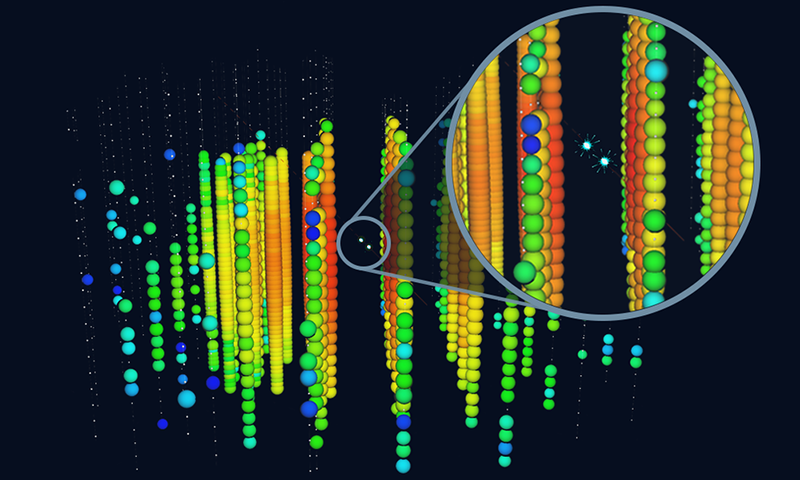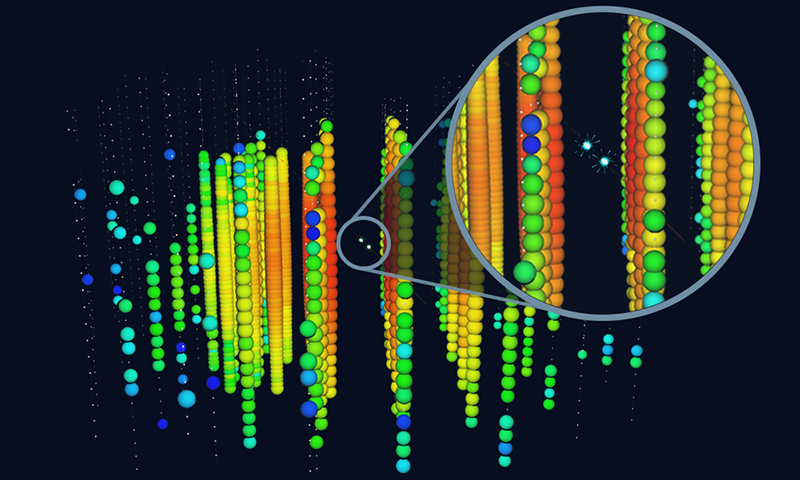Seven Astrophysical Tau Neutrinos Unmasked
Around one hundred billion neutrinos pass through your thumbnail every second. Over its decade-long history, the IceCube Neutrino Observatory in Antarctica has recorded the signals of almost a million energetic neutrinos, providing information about high-energy particle sources in the Universe. The icing on the cake would be to know which type of neutrino—electron, muon, or tau—produces a particular signal. Last year the IceCube Collaboration reported the first candidate signals directly linked to tau neutrinos [1]. Now the team confirms that one of those two signals indeed likely came from a tau neutrino and reports the observation of six more “likely tau” signals [2]. “We can’t say with absolute certainty that we have found tau neutrinos,” says Doug Cowen, a particle astrophysicist at Pennsylvania State University (PSU) and a member of the IceCube Collaboration. “But the seven signals have all the characteristics we expect for these particles.”
The IceCube Collaboration first spotted cosmic neutrinos in 2013, shortly after the observatory came online. Those neutrinos, and the others seen since then, were found using the interactions of the neutrinos with the nuclei of atoms in the 1 km3 of optically transparent glacial ice that makes up the IceCube detector. Such interactions produce charged particles that then move through the ice, emitting blue photons that optical sensors embedded in the ice then pick up.
To date, the neutrino-induced photon patterns detected by IceCube have been lumped into one of two categories: “tracks” or “cascades.” A track—the most common signature—appears as a straight line of photon detections that can extend the full length of the detector and develops after the collision of a muon neutrino with the detector’s ice. A cascade instead appears as a ball of photon detections with a radius of tens to hundreds of meters and can arise after the collision of either an electron or a tau neutrino with an atom in the ice.
The cascade signals produced by electron and tau neutrinos can be so similar that the photon patterns are hard to unambiguously link to a specific particle. For example, when an electron neutrino interacts with the IceCube detector, it produces an electron, which travels only a short distance before scattering and so creates a very localized ball of photons. A tau neutrino produces a tau lepton—a heavy cousin of the electron—that emits a photon ball both when it is produced and when it decays. But the distance between these two cascades is often so short—a few millimeters or centimeters—that the two patterns overlap and appear as one. To appear as distinct objects in the detector, the distance between the cascades must be at least 10 m, which happens for only the highest-energy tau neutrinos. And it was the signals of these particles that the collaboration has now found.
To spot these signals, Cowen and the collaboration developed an artificial intelligence model to extract candidate signals from nearly a decade of the IceCube Observatory’s data. The model was trained using double cascade patterns created by simulated tau neutrinos and by “fake” events or background noise. The model flagged seven tau-neutrino candidate events—each having energy of 20 TeV or higher, which is a million times greater than the typical MeV energies of solar neutrinos.
The technique used by IceCube represents “a major step forward” in finding rare events in the detectors, says Stephanie Wissel, also of PSU. Wissel is not part of the IceCube Collaboration but does work on IceCube-Gen2, a planned expansion of the observatory. Wissel notes that the new search method can capture unusual tau-neutrino events, but it does have limitations: it assumes that the simulated events represent the signal well, for example, and that the background is fully described in the training data. But Wissel notes that the IceCube Collaboration “included several sanity checks to ensure that the search is not subject to false positives.”
Analysis of the statistical significance of the candidate events indicated that the probability they have come from some other particle or event is less than 1 in 3.5 million, Cowen says. While the number of detected tau neutrinos may seem small, Cowen says that it matches their expectations going into the analysis. “We expected four to eight, based on other measurements of very high-energy neutrinos, and we saw seven,” he says.
“Neutrinos should come in three flavors. But only with this result is it now proven that all three flavors arrive at Earth from ultrahigh energy astrophysical sources,” says David Saltzberg, a neutrino physicist at the University of California, Los Angeles. Models predict that neutrinos oscillate between flavors as they propagate through space (see Focus: Nobel Prize—Neutrinos Oscillate), but whether these oscillations occur at such high energies and long distances had never been shown before, Saltzberg says. “Had something been wrong with our standard model of neutrino flavor, it could well have shown up in this result,” he adds. “The standard model still survives, even under this extreme test.”
The observations also have important implications for understanding distant astrophysical neutrino sources. Physicists know the proportions of electron, muon, and tau neutrinos produced on Earth, but astrophysical sources could produce neutrinos with a different starting mix of flavors, says John Beacom, a neutrino physicist from Ohio State University, who is not part of the IceCube Collaboration. “Maybe the starting point is the same, maybe it’s not, but we can only really find out by detecting all three neutrino flavors.” Now that IceCube has demonstrated this capability, physicists will be able to look for signs of new physics in the neutrino sector, Beacom says.
The astrophysical relevance of tau neutrinos could extend to other ways of viewing the Universe, as the detection of a tau neutrino could trigger a network of telescopes to search a particular patch of sky. Such multimessenger data might reveal where and how nature creates high-energy neutrinos—a still unsolved problem (see Research News: Neutrino Astronomy Enters a New Era). “The team is probably a couple of years away from being able to send out real-time alerts for tau-neutrino detections,” Cowen says. “But it’s on the horizon.”
–Katherine Wright
Katherine Wright is the Deputy Editor of Physics Magazine.
References
- R. Abbasi et al. (IceCube Collaboration), “Detection of astrophysical tau neutrino candidates in IceCube,” Eur. Phys. J. C 82, 1031 (2022).
- R. Abbasi et al. (IceCube Collaboration), “Observation of seven astrophysical tau neutrino candidates with IceCube,” Phys. Rev. Lett. 132, 151001 (2024).





